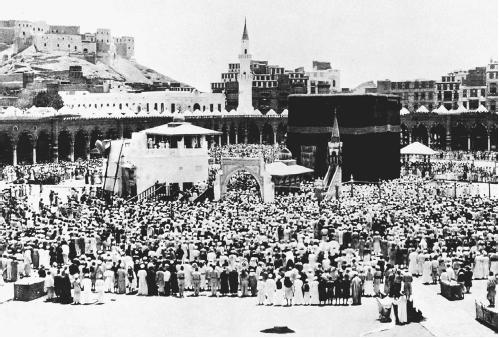MECCA
Mecca, known to the Muslim faithful as Umm al-Qura, the Mother of Cities, is the holiest place in the Islamic world. It was here that Muhammad the Prophet (c. 570–632), the Messenger of God, the founder of the Muslim faith, was born in 570, and it is here within the Great Mosque that the Ka'aba, the most sacred shrine of Islam, awaits the Muslim pilgrim. Throughout the world, wherever they may be, all devout Muslims pray five times per day, each time bowing down to face Mecca. All able-bodied Muslims who have sufficient financial means and whose absence from their families would not create a hardship must undertake a pilgrimage, a hajj, to Mecca once in their lifetime during the Muslim month of Dhu-al-Hijah (the twelfth lunar month).
Physically, Mecca is located about 45 miles east of the Red Sea port of Jedda, a city surrounded by the Sirat Mountains. Born into a well-to-do family, Muhammad married Khadija, a woman of means, and became the manager of her caravans. It was when he was about 40 years old and was meditating in a cave on Mount Hira that he had the first of a series of visions of the angel Gabriel who instructed him concerning the oneness of God. Later, Muhammad's many revelations and visions would be collected into the sacred book of Muslims, the Qur'an (or Koran), but when he first began sharing the essence of his revelations with his fellow Meccans, they rejected the teachings and reacted with great hostility when he began to lecture them concerning their vices and pagan practices.
In 622, Muhammad left Mecca for Yathrib, which was later renamed Medina, City of the Prophet, where he began to amass many followers. After eight years of strife between the people of Mecca and Muhammad, he returned to the city of his birth with an army and met with little resistance when he proceeded to cleanse the Ka'aba of pagan idols and dedicate the shrine to Allah, the One God.
On the plains of Arafat in 632, Muhammad preached to an assembled crowd that tradition numbers as some 30,000 of his followers. After he had completed his message, he declared that he had now fulfilled his mission on Earth. Two months later, he died at Medina. Within 100 years, the Muslim faith had spread from Spain to India. In the twenty-first century, Islam is one of the world's largest religions with an estimated membership of 1.2 billion.
The pilgrimage (hajj) to the sacred city of Mecca and experience of worshipping at the mosque containing the Ka'aba is strictly limited

The hajj begins with a procession called the tawaf, which takes the pilgrim around the Ka'aba seven times. The Ka'aba is a cube-shaped structure that stands about 43 feet high, with regular sides from 36 to 43 feet. The building is draped in a black cloth (kiswah) that bears a band of sacred verses embroidered in gold and silver thread. In the southeastern corner of the Ka'aba is the sacred Black Stone, an ancient holy relic about 11 inches wide and 15 inches high that has been mounted in silver. Muslims believe that Allah sent the Black Stone from heaven. It is the fortunate pilgrim who manages to break free from the press of the crowd and kiss the Black Stone. Because of the great mass of humanity crowding into the Ka'aba at any given moment, it had been decreed centuries ago that the gesture of a kiss toward the stone will suffice and merit a great blessing.
The second element of the hajj is the run seven times between two small hills, al-Safwa and al-Marwa, which are enclosed and connected with a walkway immediately adjoining the mosque courtyard. The third aspect of the pilgrimage involves walking about five miles to the town of Mina, then onward to the plain of Arafat, 10 miles farther to the east. The time of the journey is spent in prayer and meditation. As the pilgrims walk back toward Mina, they stop to throw small stones at three pillars, an act which symbolically recalls the three occasions when Abraham threw stones at Satan, who was tempting him to disobey God's command to sacrifice his son. After they walk the five miles back to Mecca, the final stage of the hajj is achieved with a festival in which a sheep, goat, cow, or camel is sacrificed to commemorate the moment when God rescinded the command to Abraham to sacrifice his son and permitted him to slay a ram and offer its blood in Isaac's stead. The hajj concludes with a final procession around the Ka'aba. The hajj generally lasts about 13 days, but when as many as two million pilgrims crowd into Mecca to observe the annual event, it may last a day or two longer to accommodate the vast numbers of the faithful.
DELVING DEEPER
Crim, Keith, general ed. The Perennial Dictionary of World Religions. San Francisco: HarperSanFrancisco, 1989.
Eerdmans' Handbook to the World's Religions. Grand Rapids, Mich.: William B. Eerdmans' Publishing Company, 1994.
Harpur, James. The Atlas of Sacred Places. Old Say-brook, Conn.: Konecky & Konecky, 1994.
Hixon, Lex. Heart of the Koran. Wheaton, Ill.: Theosophical Publishing Co., 1988.
Westwood, Jennifer. Mysterious Places. New York: Galahad Books, 1996.
User Contributions:
Comment about this article, ask questions, or add new information about this topic:
Mecca forum
